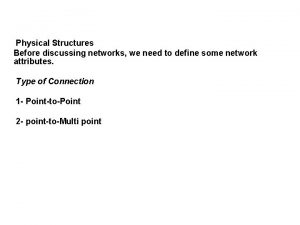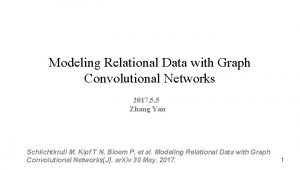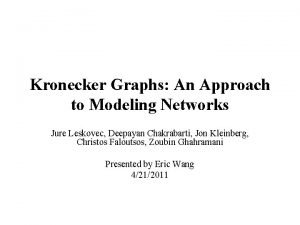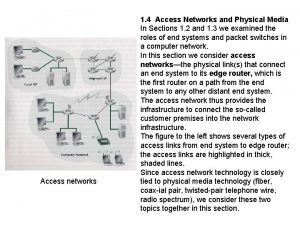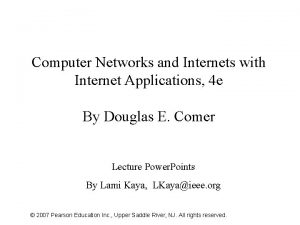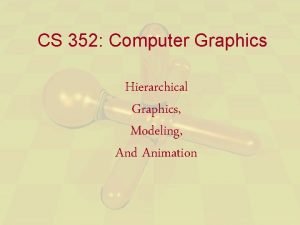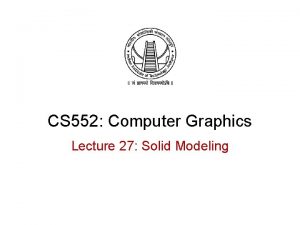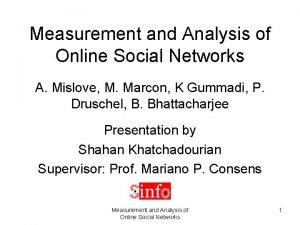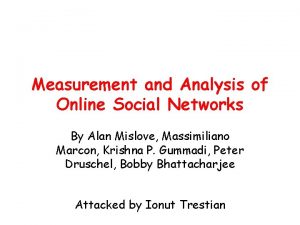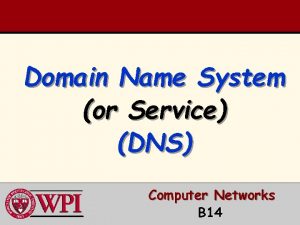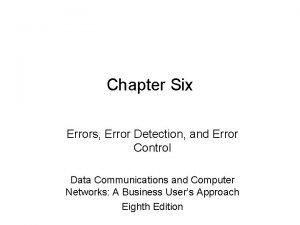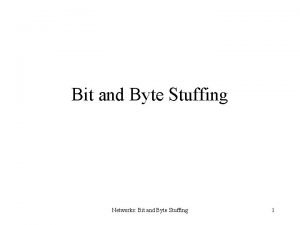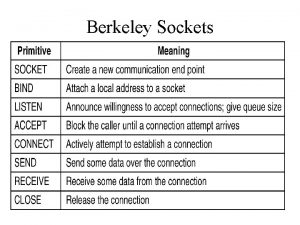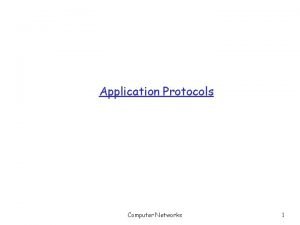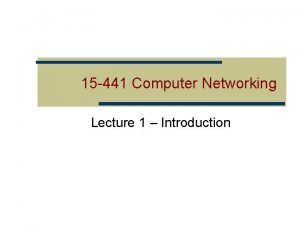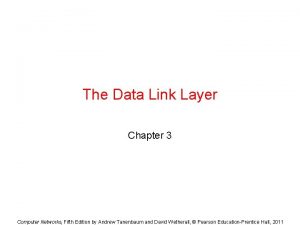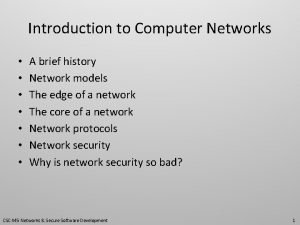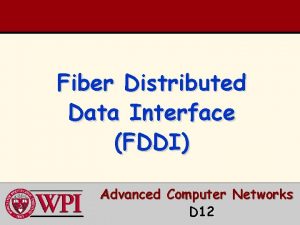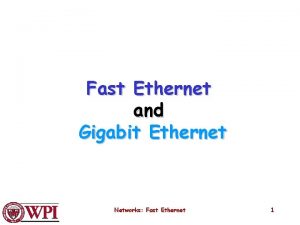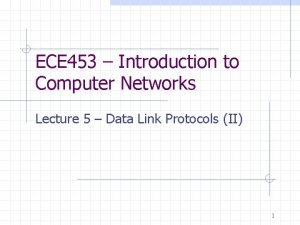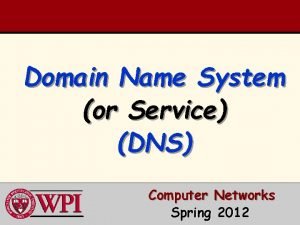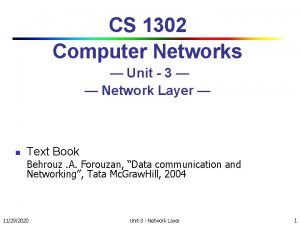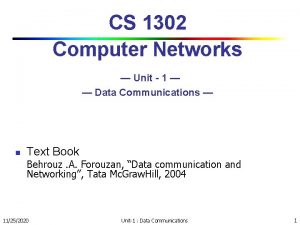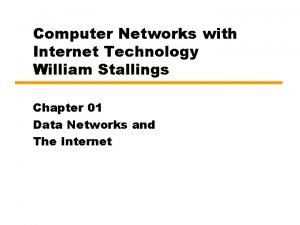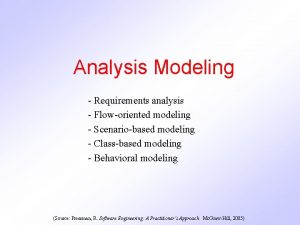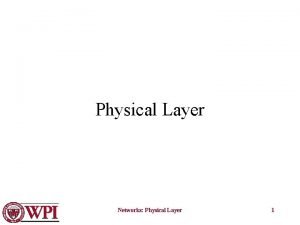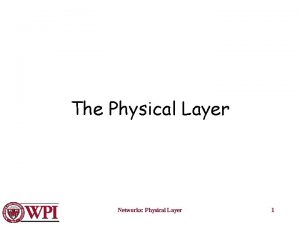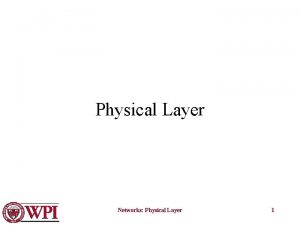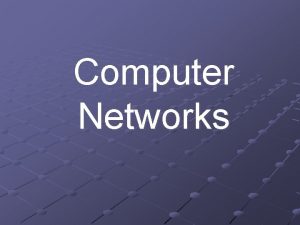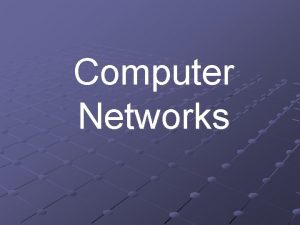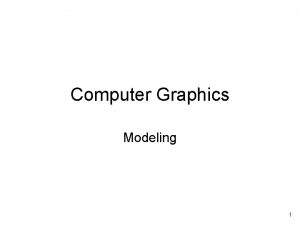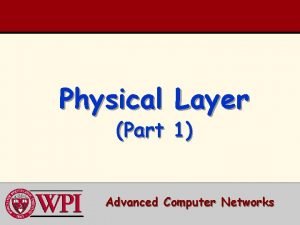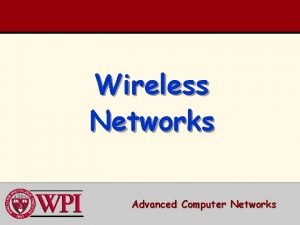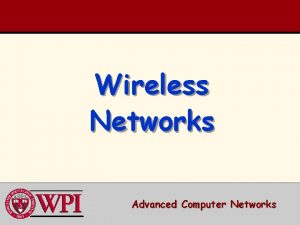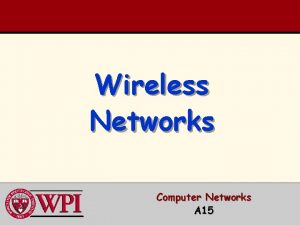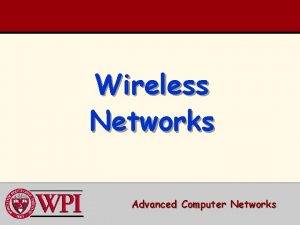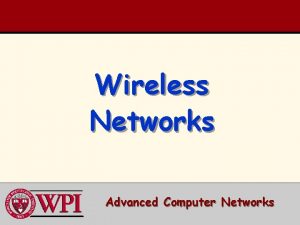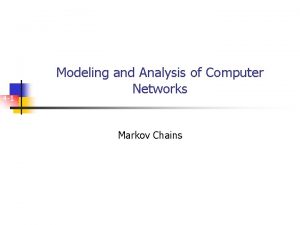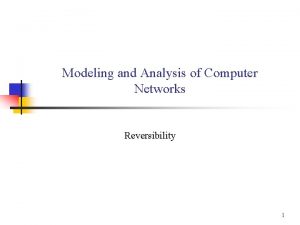Modeling and Analysis of Computer Networks The physical









































































- Slides: 73

Modeling and Analysis of Computer Networks (The physical Layer) Ali Movaghar Winter 2009

The Theoretical Basis for Data Communication Linear Time-Invariant Filtering Fourier Analysis Bandwidth-Limited Signals Maximum Data Rate of a Channel

Linear Time-Invariant Filtering § § § If input s(t) yields output r(t), then for any τ, input s(t-τ) yields output r(t- τ). If input s(t) yields output r(t), then for any real number α, αs(t) yields αr(t). If input s 1(t) yields output r 1(t) and s 2(t) yields output r 2(t), then s 1(t) + s 2(t) yields output r 1(t) + r 2(t).

Example r(t) S(t) 0 0 T 2 T 0 T 3 T 4 T 5 T 6 T 0 T T 2 T 3 T 2 T 5 T 4 T 6 T

The convolution integral formula Area ≈ δs(τ+δ) Area ≈ δs(τ) S(t) τ τ+δ Let h(t) be the impulse response of the channel. Then r(t) = s(τ) h(t-τ) dτ

Frequency Response (1) Let s(t) = ej 2πft where j = r(t) = H(f) ej 2πft H(f) = . Then where h(τ) e-j 2πfτ dτ H(f) above is called the Fourier transform of h(t).

Frequency Response (2) Let S(f) be the Fourier transform of s(t). That is S(f) = s(t) e-j 2πft dt By inverse Fourier transform, we can write s(t) = S(f) ej 2πft df It follows r(t) = H(f) S(f) ej 2πft df Thus, we get R(f) = H(f) S(f) where R(f) is the Fourier transform of r(t).

Fourier Series • Theorem: Let g(t) be a periodic function with period T. Then where f = 1/T is the fundamental frequency, an and bn are the sine and cosine amplitudes of the nth harmonics, c is a constant. We have:

Example • Let us consider the transmission of the ASCII character “b” encoded in an 8 -bit byte. The pattern that is to be transmitted is 01100010. • The Fourier analysis of this signal yields the coefficients:

Bandwidth-Limited Signals A binary signal and its root-mean-square Fourier amplitudes. (b) – (c) Successive approximations to the original signal.

Bandwidth-Limited Signals (2) (d) – (e) Successive approximations to the original signal.

Bandwidth-Limited Signals (3) Relation between data rate and harmonics.

Guided Transmission Data § § Magnetic Media Twisted Pair Coaxial Cable Fiber Optics

Magnetic Media • An industry standard Ultrium tape can hold 200 gigabytes. • A box 60 × 60 can hold about 1000 of these tapes, or 1600 trabits (1. 6 petabits). • A box of tapes can be delivered anywhere in Iran in 24 hours by “Post-e-Pishtaz”. • The effective bandwidth is 166 terabits/86, 400 sec, or 19 Gbps.

Twisted Pair (a) Category 3 UTP. (b) Category 5 UTP. • • Category 3 (16 MHz) Category 5 (100 MHz) Category 6 (250 MHz) Category 7 (600 MHz)

Coaxial Cable A coaxial cable. • Coaxial cable (1 GHz)

Fiber Optics (a) Three examples of a light ray from inside a silica fiber impinging on the air/silica boundary at different angles. (b) Light trapped by total internal reflection.

Transmission of Light through Fiber Attenuation of light through fiber in the infrared region. Attenuation in decibels = 10 log (transmitted power / received power)

Bandwidth • f = 1/λ • Example: • • df/dλ = - c/ λ 2 for λ = 1. 3 × 10 -6 We have Δf = 30 THz Δλ = 0. 17 × 10 -6 For 8 bits/Hz, we get 240 Tbps

Fiber Cables (a) Side view of a single fiber. (b) End view of a sheath with three fibers.

Fiber Cables (2) A comparison of semiconductor diodes and LEDs as light sources. • • Light Sources: LEDs and semiconductor diodes Receiving ends: Photodiodes (1 Gbps)

Fiber Optic Networks A fiber optic ring with active repeaters.

Fiber Optic Networks (2) A passive star connection in a fiber optics network.

Wireless Transmission § § § The Electromagnetic Spectrum Radio Transmission Microwave Transmission Infrared and Millimeter Waves Lightwave Transmission

The Electromagnetic Spectrum The electromagnetic spectrum and its uses for communication.

Radio Transmission (a) In the VLF, and MF bands, radio waves follow the curvature of the earth. (b) In the HF band, they bounce off the ionosphere.

Politics of the Electromagnetic Spectrum The ISM bands in the United States.

Lightwave Transmission Convection currents can interfere with laser communication systems. A bi-directional system with two lasers is pictured here.

Communication Satellites § § Geostationary Satellites Medium-Earth Orbit Satellites Low-Earth Orbit Satellites versus Fiber

Communication Satellites Communication satellites and some of their properties including altitude above the earth, round-trip delay time and number of satellites needed for global coverage.

Communication Satellites (2) The principal satellite bands.

Communication Satellites (3) VSATs using a hub.

Low-Earth Orbit Satellites Iridium (a) The Iridium satellites from six necklaces around the earth. (b) 1628 moving cells cover the earth.

Globalstar (a) Relaying in space. (b) Relaying on the ground.

Public Switched Telephone System § Structure of the Telephone System § The Politics of Telephones § The Local Loop: Modems, ADSL and Wireless § Trunks and Multiplexing § Switching

Structure of the Telephone System (a) Fully-interconnected network. (b) Centralized switch. (c) Two-level hierarchy.

Structure of the Telephone System (2) A typical circuit route for a medium-distance call.

Major Components of the Telephone System § Local loops § Analog twisted pairs going to houses and businesses § Trunks § Digital fiber optics connecting the switching offices § Switching offices § Where calls are moved from one trunk to another

The Politics of Telephones The relationship of LATAs, LECs, and IXCs. All the circles are LEC switching offices. Each hexagon belongs to the IXC whose number is on it.

The Local Loop: Modems, ADSL, and Wireless The use of both analog and digital transmissions for a computer to computer call. Conversion is done by the modems and codecs.

Amplitude Modulation (AM) • The (digital) signal s(t) (called the baseband signal) is multiplied by a sinusoidal carrier, say cos(2πf 0 t), to generate a modulated signal s(t) cos(2πf 0 t).

Amplitude Modulation (AM) • Amplitude modulation. The frequency characteristic of the waveform s(t) is shifted up and down by f 0 in frequency.

Amplitude Modulation (AM) • At the receiver, the modulated signal is again multiplied by cos(2πf 0 t), yielding a received signal r(t) = s(t) cos 2(2πf 0 t) =s(t)/2 +1/2 s(t) cos(4πf 0 t). • AM is rather sensitive to the receiver knowing the correct phase of the carrier. Fore example, if the modulated signal s(t) cos(2πf 0 t) were multiplied by sin(2πf 0 t), the low frequency demodulated waveform would disappear.

Quadrature Amplitude Modulation (QAM) • • • This suggest, however, the possibility of transmitting twice as many bits by a technique known as quadrature amplitude modulation (QAM). Here, the incoming bits are mapped into two baseband signals, s 1(t) and s 2(t). Then s 1(t) is multiplied by cos(2πf 0 t) and s 2(t) by sin(2πf 0 t); the sum of these products forms the transmitted QAM signal. The received waveform is separately multiplied by cos(2πf 0 t) and sin(2πf 0 t). The first muliplication (after filtering out the high-frequency component) yields s 1(t)/2, and the second yields s 2(t)/2.

Modems (2) cos(2πf 0 t) s 1 K bits X Pulse shape Bits to samples s 2 (a) Modulator + X Pulse shape sin(2πf 0 t) X s 1 cos(2πf 0 t) Carrier rec. sin(2πf 0 t) X (b) Demodulator Modulated waveform Timing rec. Adaptive equilizer Samples To bits s 2

Modems (2) (a) A binary signal (b) Amplitude modulation (c) Frequency modulation (d) Phase modulation

Modems (2) (a) QPSK. (b) QAM-16. (c) QAM-64.

Modems (3) (a) (b) (a) V. 32 for 9600 bps. (b) V 32 bis for 14, 400 bps.

Digital Subscriber Lines Bandwidth versus distanced over category 3 UTP for DSL.

Digital Subscriber Lines (2) Operation of ADSL using discrete multitone modulation.

Digital Subscriber Lines (3) A typical ADSL equipment configuration.

Wireless Local Loops Architecture of an LMDS system.

Frequency Division Multiplexing (a) The original bandwidths. (b) The bandwidths raised in frequency. (b) The multiplexed channel.

Wavelength Division Multiplexing Wavelength division multiplexing.

Time Division Multiplexing The T 1 carrier (1. 544 Mbps).

Time Division Multiplexing (2) Delta modulation.

Time Division Multiplexing (3) Multiplexing T 1 streams into higher carriers.

Time Division Multiplexing (4) Two back-to-back SONET frames.

Time Division Multiplexing (5) SONET and SDH multiplex rates.

The Mobile Telephone System § First-Generation Mobile Phones: Analog Voice § Second-Generation Mobile Phones: Digital Voice § Third-Generation Mobile Phones: Digital Voice and Data

Advanced Mobile Phone System (a) Frequencies are not reused in adjacent cells. (b) To add more users, smaller cells can be used.

Channel Categories The 832 channels are divided into four categories: § Control (base to mobile) to manage the system § Paging (base to mobile) to alert users to calls for them § Access (bidirectional) for call setup and channel assignment § Data (bidirectional) for voice, fax, or data

D-AMPS Digital Advanced Mobile Phone System (a) A D-AMPS channel with three users. (b) A D-AMPS channel with six users.

GSM Global System for Mobile Communications GSM uses 124 frequency channels, each of which uses an eight-slot TDM system

GSM (2) A portion of the GSM framing structure.

CDMA – Code Division Multiple Access (a) Binary chip sequences for four stations (b) Bipolar chip sequences (c) Six examples of transmissions (d) Recovery of station C’s signal

Third-Generation Mobile Phones: Digital Voice and Data Basic services an IMT-2000 network should provide: § § High-quality voice transmission Messaging (replace e-mail, fax, SMS, chat, etc. ) Multimedia (music, videos, films, TV, etc. ) Internet access (web surfing, w/multimedia. )

Cable Television § § § Community Antenna Television Internet over Cable Spectrum Allocation Cable Modems ADSL versus Cable

Community Antenna Television An early cable television system.

Internet over Cable television

Internet over Cable (2) The fixed telephone system.

Spectrum Allocation Frequency allocation in a typical cable TV system used for Internet access

Cable Modems Typical details of the upstream and downstream channels in North America.
 Datagram vs virtual circuit
Datagram vs virtual circuit Basestore iptv
Basestore iptv Helen erickson nursing theory
Helen erickson nursing theory Physical structures in computer networks
Physical structures in computer networks Relational modeling vs dimensional modeling
Relational modeling vs dimensional modeling Modeling relational data with graph convolutional networks
Modeling relational data with graph convolutional networks Kronecker graph
Kronecker graph Computational engineering and physical modeling
Computational engineering and physical modeling Access networks and physical media
Access networks and physical media Intserv vs diffserv
Intserv vs diffserv Error detection in computer networks
Error detection in computer networks Byte stuffing and bit stuffing
Byte stuffing and bit stuffing Byte stuffing in computer network
Byte stuffing in computer network Arp vs rarp
Arp vs rarp Analogue and digital transmission in computer networks
Analogue and digital transmission in computer networks Web and http in computer networks
Web and http in computer networks Computer networks and internets with internet applications
Computer networks and internets with internet applications Error detection and correction in computer networks
Error detection and correction in computer networks Protocols and standards in computer networks
Protocols and standards in computer networks Error detection computer networks
Error detection computer networks Computer networks and internets
Computer networks and internets Simulation modeling and analysis law kelton
Simulation modeling and analysis law kelton Dfd fragment
Dfd fragment System requirements checklist output example
System requirements checklist output example Job analysis and competency modeling
Job analysis and competency modeling Manufacturing systems modeling and analysis
Manufacturing systems modeling and analysis Job rewards matrix
Job rewards matrix Computer graphics
Computer graphics Hierarchical modeling in computer graphics
Hierarchical modeling in computer graphics Solid modeling in computer graphics
Solid modeling in computer graphics Measurement and analysis of online social networks
Measurement and analysis of online social networks Measurement and analysis of online social networks
Measurement and analysis of online social networks Crc in computer networks
Crc in computer networks Crc in computer networks
Crc in computer networks Traffic management in computer networks
Traffic management in computer networks Tpdu in computer networks
Tpdu in computer networks What is optimality principle in computer networks
What is optimality principle in computer networks In band management definition
In band management definition What is optimality principle in computer networks
What is optimality principle in computer networks Uses of computer networks in business applications
Uses of computer networks in business applications Classify computer networks based of transmission technology
Classify computer networks based of transmission technology Intro dns
Intro dns Icmp in computer networks
Icmp in computer networks Framing in computer network
Framing in computer network Dns in computer networks
Dns in computer networks Computer networks assignment
Computer networks assignment Distributed systems vs computer networks
Distributed systems vs computer networks Badrinath
Badrinath Internet transport protocol in computer networks
Internet transport protocol in computer networks Error control in computer networks
Error control in computer networks What is optimality principle in computer networks
What is optimality principle in computer networks Data link layer switching
Data link layer switching Apdatal
Apdatal Flag bytes with byte stuffing
Flag bytes with byte stuffing Berkley sockets
Berkley sockets In ftp protocol client contacts server using
In ftp protocol client contacts server using Principles of network applications in computer networks
Principles of network applications in computer networks Https://speakerdeck.com/
Https://speakerdeck.com/ 15441 cmu
15441 cmu A utopian simplex protocol
A utopian simplex protocol Sonet architecture
Sonet architecture Connectionless internetworking
Connectionless internetworking O s i reference model ka chitra
O s i reference model ka chitra The network layer is concerned with of data.
The network layer is concerned with of data. Brief history of computer network
Brief history of computer network What is fddi
What is fddi Fast ethernet in computer networks
Fast ethernet in computer networks Ethernet frame format
Ethernet frame format Unrestricted simplex protocol in computer networks
Unrestricted simplex protocol in computer networks Dns in computer networks
Dns in computer networks Cs 1302
Cs 1302 Data communication components
Data communication components Principles of congestion control in computer networks
Principles of congestion control in computer networks William stallings computer networks
William stallings computer networks



